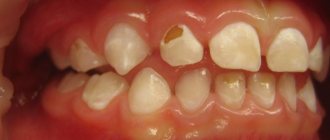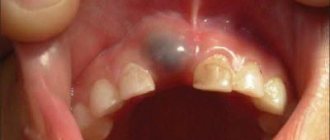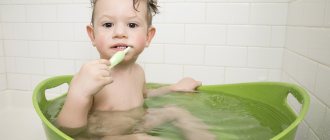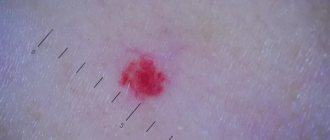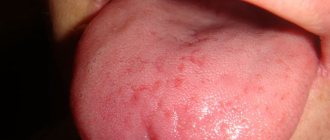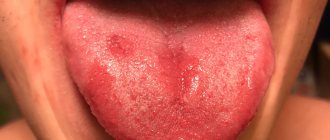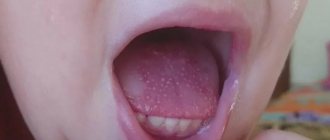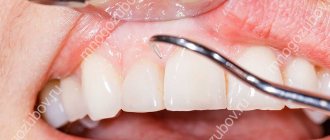What is atopic dermatitis
Atopic dermatitis is a chronic skin disease characterized by a relapsing course.
Babies with atopic dermatitis are bothered by itching and dry skin. Foci of inflammation can be located throughout the body, but they especially “love” children’s cheeks and folds, as well as the area under the diaper. Statistics indicate that atopic dermatitis occurs in every fifth baby [1]. Why is he dangerous? Lack of treatment can lead to the development of severe forms of atopic dermatitis, the spread of inflammation and the atopic march. In this condition, the disease begins to “march” through the child’s body, provoking the appearance or exacerbation of concomitant diseases. In 20-43% of cases, the development of bronchial asthma is possible, and twice as often - allergic rhinitis or eczema [2].
In addition, disruption of the hydrolipid barrier that occurs with atopic dermatitis in children can cause a secondary infection. Unfortunately, atopic dermatitis cannot be “outgrown.”
Symptoms of atopic dermatitis in children
According to recent studies [3], in 45% of babies, atopic dermatitis debuts between the ages of two and six months. In 60% of patients during the first year of life.
With atopic dermatitis in children, clinical symptoms and localization of inflammation largely depend on age. There are infant (up to one and a half years), child (from one and a half years to puberty) and adult phases. The following symptoms are common to all phases:
- Severe dryness of the skin (xerosis), which cannot be treated with regular baby cream .
- Redness and inflammation on the skin (especially symmetrical ones).
- Itching, causing severe discomfort to the child.
- Recurrent course (alternating periods of remissions and exacerbations). Moreover, in the cold season, deterioration is more often observed, and in the warm season, improvement is observed.
According to the nature of the course, acute and chronic stages of atopic dermatitis are distinguished, which are expressed by different signs (symptoms):
● Acute stage. Rough red spots (erythema), nodular rashes (papules), swelling, and crusts (including weeping) may appear on the baby's skin.
● Chronic stage. Accompanied by lichenification (thickening of the skin), cracks on the soles and palms, scratching, and increased pigmentation of the skin of the eyelids.
Causes of atopic dermatitis in children
Atopic dermatitis can be considered a hereditary disease, because the most important role in its occurrence is played by a genetic factor [3]:
- In 80% of children, it occurs if both parents have or have had atopic dermatitis.
- In more than 50% of children - if at least one of the parents was sick, especially the mother (this doubles the risk of transmitting the disease “by inheritance”).
Some prenatal factors can also provoke atopic dermatitis in a baby: for example, poor nutrition of the expectant mother, contact with toxic substances, infections suffered during pregnancy, as well as bad habits and stress.
In addition, atopic dermatitis more often develops in babies who suffered oxygen deprivation during childbirth, were born prematurely and were bottle-fed (perinatal factors).
Diagnosis of atopic dermatitis in children
For a long time it was believed that atopic dermatitis in children is predominantly an allergic disease. However, it has now been proven that this is, first of all, a disease with dysfunction of the epidermis! And food allergies are detected only in 30-40% of children with atopic dermatitis.
The symptoms of atopic dermatitis are almost always influenced by certain environmental triggers. This could be chlorinated or “hard” water, soap, contact with an allergen, unfavorable climate and even stress. Another common trigger is bacteria that enter the skin through a damaged epidermal barrier.
Only a doctor (pediatrician, dermatologist, allergist) can make a diagnosis of “atopic dermatitis in children”! It takes into account the presence of external signs of disease and itching, as well as hereditary factors. Laboratory tests may be prescribed for children to carry out diagnostics. For example:
- General detailed (clinical) blood test.
- Biochemical general therapeutic blood test.
- General (clinical) urine analysis.
- Study of the level of total immunoglobulin E in the blood.
- Skin testing with allergens.
- Skin biopsy.
Diagnostic methods
Any suspicious formations on the baby’s skin, regardless of his age, should be shown to a pediatric dermatologist. The doctor will take a detailed history, examine pathological areas using a Wood's lamp or a dermatoscope, and also palpate whitish formations.
If this is not enough to make a diagnosis, the little patient will receive a referral to:
- Ultrasound;
- X-ray;
- MRI or CT;
- angiography;
- biopsy;
- general urine and blood tests.
You may need additional consultation with a pediatric endocrinologist, psychologist, surgeon or other specialists. After making a diagnosis, the doctor will give an explanation and prescribe therapy, if necessary.
Treatment of atopic dermatitis in children
In modern medicine, there are three degrees of severity of atopic dermatitis in children:
- Easy. The child responds well to treatment, remission can last more than 10 months, the itching is minor, the redness is slight. Exacerbations occur no more than twice a year.
- Medium-heavy. Exacerbations occur 3-4 times a year, and periods of remission are reduced to 2-3 months. The therapy gives less pronounced results, the redness “stubbornly” returns.
- Heavy. Long-term exacerbations are interrupted by short periods of remission - up to one and a half months. Treatment helps little or for a short period of time; the baby’s behavior is greatly affected by itching [4].
At all stages of atopic dermatitis, pediatricians and dermatologists recommend emollients - cosmetic skin care products. They moisturize the skin and help restore the level of lipids - the most important structural components. During periods of exacerbation, emollients can be applied frequently and generously.
Pay attention to the composition; it is advisable that emollients are not addictive. Their main tasks are to help the skin produce its own lipids, providing effective hydration and softening. In addition, the constant use of emollients prolongs periods of remission and alleviates the symptoms of atopic dermatitis.
The Mustela Stelatopia line of cosmetics will help restore skin comfort for a long time! Stelatopia emollients are effective at all stages of atopic dermatitis , incl. at its first signs - increased dryness of the skin.
Studies have confirmed that the use of Stelatopia emollient cream can reduce the likelihood of developing atopic dermatitis by 51% ! [6]
Treatment (use of hormonal drugs) for atopic dermatitis in children can only be prescribed by a doctor, taking into account age, symptoms, concomitant diseases and test results. Self-medication can be dangerous!
- For external therapy for moderate and severe degrees of atopic dermatitis, topical glucocorticosteroids, topical calcineurin inhibitors and others are used.
- In case of mild disease, the use of Stelatopia Emollient Cream reduces the severity of inflammation after 32 hours, due to the presence of sunflower oil in the distillate [5].
- In systemic therapy, the drugs dupilumab, cyclosporine, glucocorticosteroids and others are used orally or in injection forms.
- To relieve itching - clemastine, hifenadine, cetirizine, chloropyramine, levocetirizine and others. The use of Stelatopia emollient cream as a cosmetic skin care product reduces the severity of itching in 80% of cases [7].
- Physiotherapy treatment may include phototherapy. Sometimes, in the treatment of atopic dermatitis, diet therapy, acupuncture, plasmapheresis and some other methods may be prescribed.
Treatment
There is no single therapeutic method provided. The treatment regimen is prescribed after diagnosis. This may include:
- use of corticosteroid ointments, tablets, injections;
- irradiation with UV lamps;
- physiotherapy (electrophoresis, magnetotherapy, paraffin baths);
- minimally invasive methods for eliminating cosmetic defects (laser therapy, cryodestruction, radioknife, electrocoagulation);
- surgical excision of pathological areas if serious pathologies are suspected;
- physical therapy;
- sedatives;
- antifungal ointments;
- diet correction;
- vitamin complexes;
- iron supplements;
- visiting a sanatorium;
- psychotherapy sessions and more.
Traditional treatment can be supplemented with folk remedies, acupuncture, massage, homeopathy and other methods, if the doctor does not object and considers their use appropriate.
Some diseases can be treated for more than one year and may recur. This applies to vitiligo, psoriasis and pityriasis rosea.
Prevention of atopic dermatitis in children
For atopic dermatitis, primary, secondary and tertiary preventive measures are distinguished.
Primary prevention
is aimed at preventing the occurrence of atopic dermatitis in children.
Recommended:
- Expectant mothers with a tendency to allergic reactions should exclude allergenic foods from their diet.
- Introducing complementary foods to babies begins at four months of age.
- Pregnant women and newborns at risk should take probiotics containing lactobacilli.
- Practice breastfeeding whenever possible.
- Eliminate exposure of your baby to tobacco smoke.
- Maintain humidity levels and regularly ventilate the children's room.
Secondary prevention
is aimed at eliminating risk factors that, under certain conditions (stress, weakened immunity, etc.) can lead to the occurrence, exacerbation and relapse of atopic dermatitis.
Recommended:
- Regular consultations with specialists.
- Maintaining awareness of new research and drugs in the treatment of atopic dermatitis.
3.Tertiary prevention
is a set of measures aimed at preventing exacerbations or development of complications of atopic dermatitis.
Recommended:
- Avoid contact of the baby with provoking factors: soap (it dries the skin), clothes made of rough or synthetic fabrics, low-quality cosmetics, etc.
- Take care of your child's skin and apply emollients on a regular basis, including during periods of remission.
- Bath your baby daily using cosmetic cleansers for atopic skin.
[1] Isaac Steering Committee. (1998). Worldwide variation in prevalence of symptoms of asthma. The Lancet, 351, 1225-1235. (International Committee on Asthma and Allergy in Childhood 1998. Worldwide differences in the prevalence of asthma symptoms. The Lancet, 351, 1225-1235). [2] Studies Watson W., 2011, Larsen F.S., 2002, Draaisma E., 2015, ISAAC Steering Committee, 1998. (Studies Watson W., 2011, Larsen F.S., 2002, Draaisma E., 2015 International Committee on the study of asthma and allergies in childhood, 1998). [3] Clinical guidelines. Atopic dermatitis, 2022. [4] Atopic dermatitis: recommendations for practitioners. Russian national consensus document on atopic dermatitis. Ed. P.M. Khaitova, A.A. Kubanova. M.: Pharmacus Print, 2002. 192 p. [5] ODT and inflammation June 2010 [6] Scientific dossier “Atopic-prone skin: latest discoveries” [7] Test report “Stelatopia” emollient cream, self-assessment by users
Reasons for appearance
There are quite a lot of diseases that provoke pigmentation disorders, but the mechanism of their occurrence has not been studied enough.
It is believed that the following factors can provoke them:
- harmful effects of ultraviolet radiation;
- genetic disorders;
- negative impact on the embryo in the womb (bad habits of the mother, taking medications);
- infectious diseases;
- hormonal disorders;
- problems with the nervous system;
- damage to the digestive tract;
- malfunction of the immune system.
The spots that were present at birth will most likely remain forever. Acquired ones often occur against the background of impaired immune function and are amenable to medical correction.
Vitiligo
The etiology and pathogenesis of the disease have not been sufficiently studied. The main version is a malfunction of the immune system. T lymphocytes perceive pigment cells as a foreign object and block their work.
Autoimmune disorders are inherited or develop under the influence of negative factors. These include:
- excessive tanning;
- chronic infectious processes;
- stress and so on.
The main symptom is the appearance of light or pink spots of different sizes and locations. They are characterized by symmetry. For example, if one cheek is lightened, then after a while the stain will appear on the second. The disease develops gradually. When located close together, the foci merge, forming large discolored islands.
The pathology is not contagious, does not cause any discomfort and does not affect the physical condition.
Many parents tell on forums that shortly before the disease, the spots begin to itch and only then lighten.
The risk group includes dark-skinned children with a hereditary predisposition to vitiligo.
Idiopathic guttate hypomelanosis
In infants, this pathology is diagnosed extremely rarely. It often appears in adult men and women over 30–40 years of age. What causes the discoloration is unknown. According to one version, guttate hypomelanosis is one of the signs of photoaging (changes in the skin against the background of regular excess ultraviolet radiation). Diagnosing such a disease in a one-year-old or two-year-old child is rare.
Other reasons for the development of the disease include congenital predisposition and infectious factors.
Drop-shaped spots are distinguished by the absence of discomfort, small size, and characteristic localization in the area of flexion of the leg or arm. The back and shoulders are less likely to suffer.
Fungal infections
This group includes a complex of diseases caused by representatives of fungal flora. Microorganisms provoke the appearance of itchy lesions covered with dry white or yellowish scales.
After a course of treatment with antifungal drugs, the unpleasant symptoms disappear, the surface stops peeling, and whitish marks remain on the body. Lightening occurs due to disruption of melanin synthesis in certain areas.
When the effect of toxic substances secreted by fungi weakens, the skin gradually recovers and acquires a natural color. If this does not happen, the infection may still need to be treated.
Pityriasis versicolor (lichen versicolor)
With multi-colored lichen, itchy lesions appear, covered with small scales of different shades. The reason for their appearance is the activation of the Pityrosporum fungus, which turns into the pathogenic form of Malassezia furfur and affects the skin. Pathology is not transmitted to healthy children, because the growth of pathogenic microorganisms and their transformation is restrained by strong immunity.
Children who are often ill or suffer from hormonal imbalances are at risk of contracting this form of lichen. Sometimes pityriasis versicolor occurs as a result of prolonged treatment with corticosteroid drugs or excess ultraviolet radiation.
Gilbert's pityriasis rosea
The exact reasons for the development of the disease are unclear, but reduced immunity is not the least important. Most likely, the triggering factor is an infectious irritant, namely:
- herpes simplex types 1 and 2;
- cytomegalovirus;
- Epstein-Barr virus and others.
Gilbert's disease manifests itself as pink rashes that gradually lighten. The neck, back and abdomen are most often affected. Within 8 weeks, clinical signs subside and the body clears up.
If the virus reactivates, symptoms may return.
White pityriasis
This is the name of a dermatological disease, popularly called lichen white or lichen simplex. It provokes the appearance of light spots on the face, neck, shoulders or arms. Other localizations are less common.
It is believed that the disease is caused by a decrease in immunity and the proliferation of pathogenic microorganisms, for example, the Malasseziafurfur fungus or streptococci.
Most often, white pityriasis occurs where there has recently been eczema, psoriasis or dermatitis.
Pigmentless nevus
This is the name for light spots or nodules that are slightly different in color from the surrounding tissue. Depending on their structure, they can be smooth or rough, flat or convex. They often appear in the first 2 years after birth, but they also occur in infants. Intensive growth of non-pigmented and pigmented formations occurs during puberty.
If the structure of the nevus does not cause concern to doctors, then most likely there is no need to worry. Asymmetrical, inflamed moles that grow quickly are at risk of degenerating into melanoma. This type of skin cancer is very rare, especially among young people.
Poor nutrition
The problem is common among children suffering from a lack of calcium and vitamins E, D. The deficiency may be due to insufficient intake or incomplete absorption of nutrients. In the first case, it is enough to normalize the diet, and in the second, an examination will be required to help determine the cause and select treatment.
Judging by the reviews on the forums, poor appetite in a baby is a common problem that worries many parents. Reluctance to eat or aversion to certain foods may indicate gastrointestinal diseases and infection.
If a white spot on a child’s body is combined with poor appetite and poor health, you definitely need to go to the doctor.
Other versions
Other reasons can also lead to focal skin lightening, namely:
- psoriasis;
- deep hemangioma;
- partial albinism;
- consequences of thermal or sunburn;
- Raynaud's syndrome, if the lightening is localized on the terminal phalanges of the fingers;
- taking certain medications, especially hormonal ones;
- an allergic reaction that provokes an autoimmune attack on pigment cells;
- psychosomatics;
- VSD (vegetative-vascular dystonia);
- non-pigmented melanoma.
If your baby has a coated tongue, there are most likely problems with the digestive tract:
- inflammation of internal organs;
- dysbacteriosis;
- cholecystitis;
- congenital bending of the bile duct.
The most common cause of pigmentation disorders is considered to be decreased immunity. This is due to the modern lifestyle, rare walks, and the free sale of antibiotics, which are often fed to children, guided only by the description of the drug.
